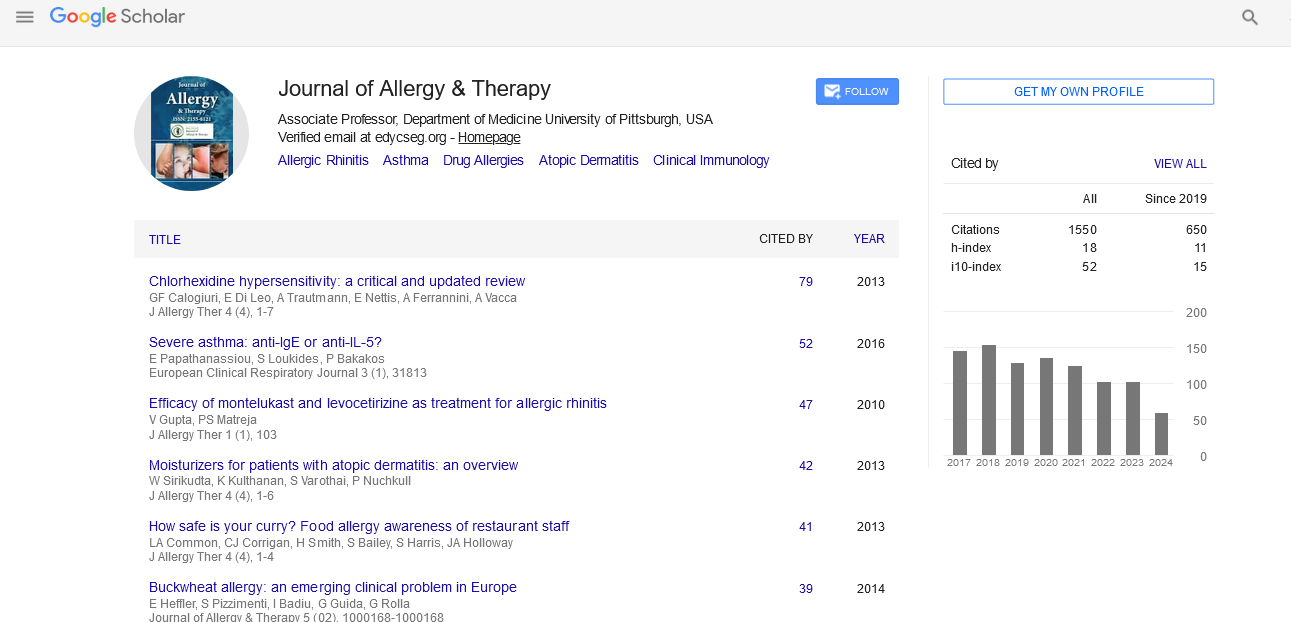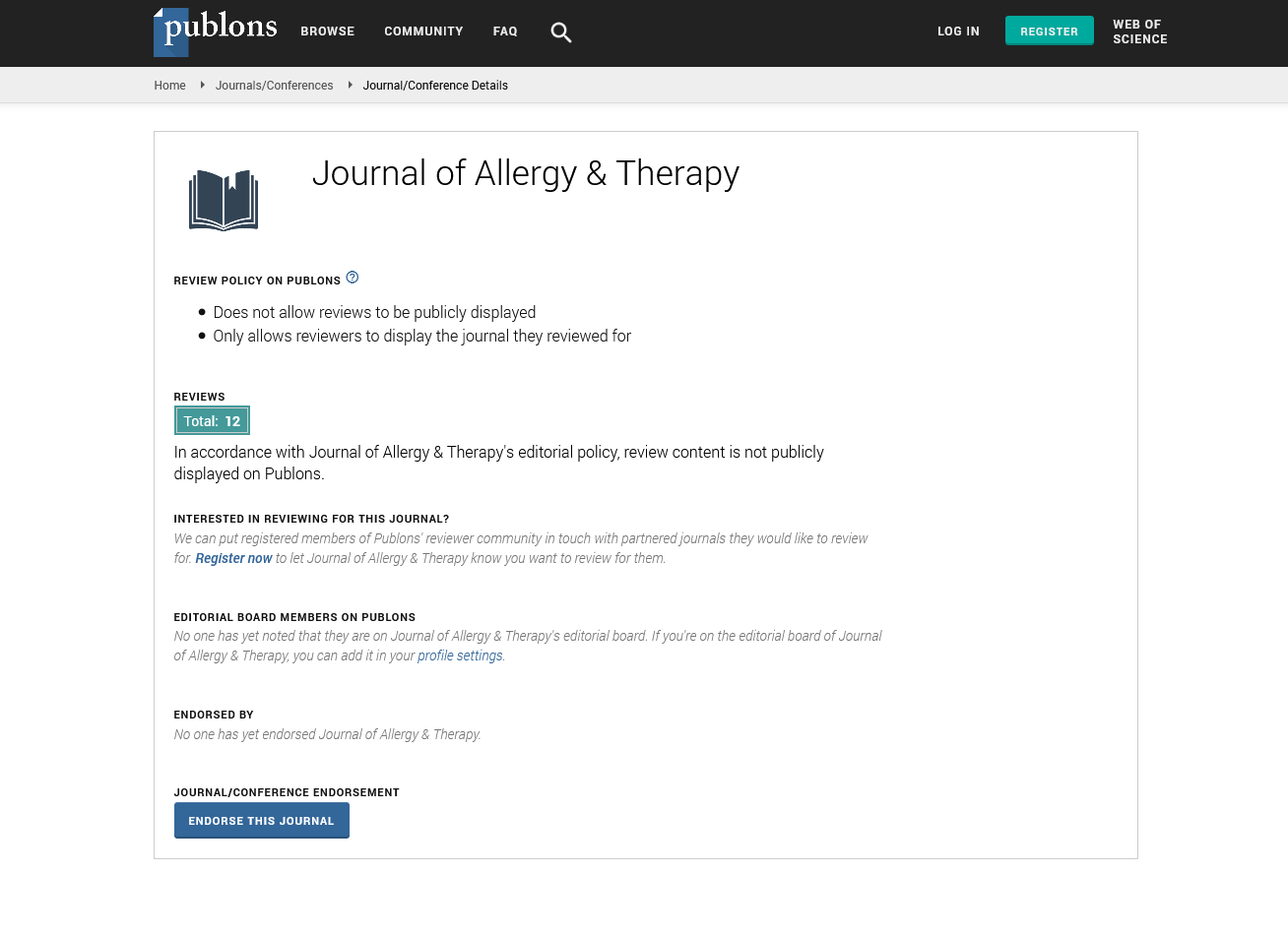PMC/PubMed Indexed Articles
Indexed In
- Academic Journals Database
- Open J Gate
- Genamics JournalSeek
- Academic Keys
- JournalTOCs
- China National Knowledge Infrastructure (CNKI)
- Ulrich's Periodicals Directory
- Electronic Journals Library
- RefSeek
- Hamdard University
- EBSCO A-Z
- OCLC- WorldCat
- SWB online catalog
- Virtual Library of Biology (vifabio)
- Publons
- Geneva Foundation for Medical Education and Research
- Euro Pub
- Google Scholar
Useful Links
Share This Page
Journal Flyer

Open Access Journals
- Agri and Aquaculture
- Biochemistry
- Bioinformatics & Systems Biology
- Business & Management
- Chemistry
- Clinical Sciences
- Engineering
- Food & Nutrition
- General Science
- Genetics & Molecular Biology
- Immunology & Microbiology
- Medical Sciences
- Neuroscience & Psychology
- Nursing & Health Care
- Pharmaceutical Sciences
Opinion Article - (2024) Volume 15, Issue 4
Precision in Allergy Diagnosis: Advancements in Technology and Personalized Healthcare
Peter Barnes*Received: 29-Nov-2024, Manuscript No. JAT-24-28024; Editor assigned: 02-Dec-2024, Pre QC No. JAT-24-28024 (PQ); Reviewed: 16-Dec-2024, QC No. JAT-24-28024; Revised: 23-Dec-2024, Manuscript No. JAT-24-28024 (R); Published: 30-Dec-2024, DOI: 10.35248/2155-6121.24.15.404
Description
Technological advancements are revolutionizing allergy diagnostic methodologies, transforming traditional approaches into experienced, precision-driven strategies. Modern diagnostic technologies integrate artificial intelligence, molecular analysis and computational modeling to provide unprecedented insights into allergic mechanisms. Artificial intelligence emerges as a transformative technological frontier in allergy diagnostics. Machine learning algorithms can analyze complex immunological datasets, identifying subtle patterns and predicting potential allergic reactions with remarkable accuracy. These computational models integrate genetic information, molecular markers and clinical observations to create comprehensive risk assessment frameworks. Advanced molecular diagnostic techniques represent another critical technological innovation. Next-generation sequencing technologies enable researchers to map intricate genetic variations associated with allergic susceptibilities. By identifying specific genetic markers, clinicians can develop personalized intervention strategies tailored to individual immunological profiles. Proteomics and metabolomics offer sophisticated diagnostic dimensions.
These technologies analyze protein expressions and metabolic signatures, revealing complex interactions between genetic predispositions and immune system responses. Mass spectrometry techniques provide detailed molecular characterization, uncovering subtle immunological variations previously undetectable through conventional diagnostic methods. Computational immunology platforms are revolutionizing diagnostic capabilities. These advanced systems integrate multiple data sources, including genetic profiles, clinical histories and environmental exposures, to generate comprehensive immunological risk assessments. Machine learning algorithms can predict potential allergic responses with increasing precision. Microfluidic technologies represent a groundbreaking diagnostic approach. These miniaturized diagnostic platforms enable rapid, precise allergen detection through microscale fluid manipulation. Microfluidic chips can simultaneously analyze multiple allergenic components, providing comprehensive immunological profiles with minimal sample requirements.
Wearable diagnostic technologies are emerging as innovative monitoring tools. Smart biosensors can continuously track physiological responses, providing real-time immunological data. These devices potential unprecedented insights into individual allergic response mechanisms, enabling more proactive management strategies. Genetic editing technologies like CRISPR offer potential therapeutic innovations. While primarily experimental, these technologies demonstrate potential capabilities in modifying immune system responses. Researchers explore potential genetic interventions to mitigate allergic susceptibilities. Nanotechnology introduces sophisticated diagnostic capabilities. Nanoparticle-based diagnostic platforms can detect minute allergenic molecules with extraordinary precision. These technologies potential more sensitive, comprehensive allergen identification methodologies. Global research collaborations are accelerating technological diagnostic innovations. International research networks enable knowledge sharing, standardization of diagnostic approaches and development of more comprehensive technological frameworks. Ethical considerations remain paramount in developing advanced diagnostic technologies. Researchers must navigate complex privacy concerns, ensure patient consent and develop transparent technological implementation strategies. Economic implications of technological innovations are substantial.
Advanced diagnostic technologies can potentially reduce longterm healthcare expenditures by enabling more precise, targeted interventions. By identifying high-risk individuals early, preventive strategies can minimize chronic health complications. Public health perspectives highlight the transformative potential of these technological innovations. Advanced diagnostic capabilities potential more personalized, proactive healthcare approaches. By understanding individual immunological variations, healthcare systems can develop more effective intervention strategies. Interdisciplinary collaboration emerges as a critical component in advancing diagnostic technologies. Immunologists, computational experts, geneticists and technological innovators must work synergistically to unlock new diagnostic capabilities.
In conclusion, technological innovations in allergy diagnostics represent a revolutionary approach to understanding individual immunological vulnerabilities. By combining advanced computational technologies, molecular analysis and sophisticated diagnostic platforms, researchers can develop more precise, personalized medical interventions. Future research must continue exploring technological frontiers, promising unprecedented insights into human immunological complexity.
Citation: Barnes P (2024). Precision in Allergy Diagnosis: Advancements in Technology and Personalized Healthcare. J Allergy Ther. 15:404.
Copyright: © 2024 Barnes P. This is an open access article distributed under the terms of the Creative Commons Attribution License, which permits unrestricted use, distribution, and reproduction in any medium, provided the original author and source are credited.


